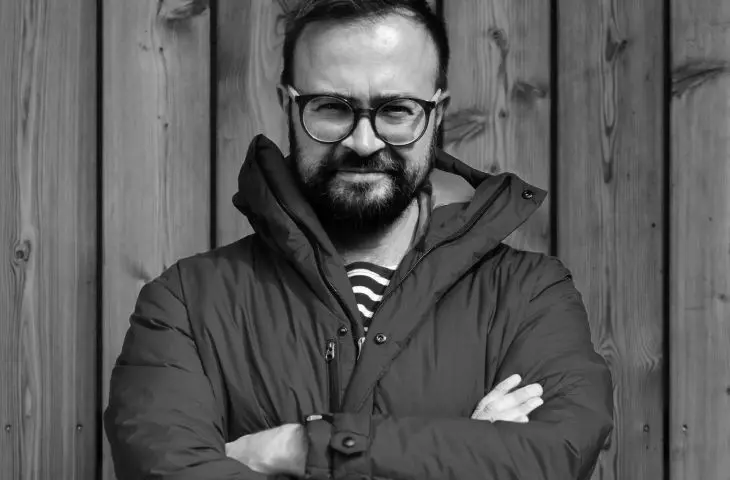column by Jakub Szczęsny from A&B issue 12 | 2021
On a yellow shelf cut in a fancy wave in my father's studio stands a book by Mieczyslaw Twarowski titled "The Sun in Architecture." I reach for it every time I drop by for a visit and when we are not engaged in conversation about current topics. I can say that, as a child of architects, I grew up not only on Arkady's album publications, but especially in the worship of the Big Yellow Ball.
Yes, shudder the Minister of Lublin: in the home of my childhood, a certain Jewish bearded man walking on water was less important than conversations about chiaroscuro and the importance of the sun. Perhaps we were hidden followers of the Sun God or some suspicious (from the Minister's point of view) Zoroastrians? What's more, my own father, after a regular job in a state design office, spent more than one night drawing mosques (!) for a certain enterprising Syrian, who picked up tubes of drawings from "anonymous" Warsaw architects with one hand and paid with very green currency with the other, on his way to and from Okęcie airport. Mosques, hotels, villas and modern versions of souks were, of course, later signed with the name of this gentleman, and my father, nor, presumably, other Polish execs, ever found out how many of them were built, or if they were, how many of them were later destroyed by war, time or consumed by the sands of the desert.
I also profited from this cottage industry - and not only by being gifted with resoraks from Pewex, but also by being invited by my parent to participate in drawing prospects. My role was to fill in the stretches of the Arabs' beloved English lawns, so natural and obvious in the Maghreb and Asia Minor, with strokes. I also drew palm trees of any size and, when I matured a bit in technique, figures in the background, especially women shackled in indefinite "rags" - their shackling relieved me somewhat of the need to keep the proportions that drawing men required. Light shading, however, was handled by my father: it was he who knew, probably also thanks to the "sun ruler" described by Twarowski, how exactly the shadows drawn with a gray marker on a rapidograph line would line up. A few years later, as a fifteen-year-old illustrator for "Nowa Fantastyka" and even later for the Polish edition of "Playboy," I was applying the chiaroscuro tricks I had picked up from my father to stories about fictional cities or buildings, and supporting with illustrations the columns of a certain Korwin-Mikke, then writing for a magazine with "bunnies."
The southwestern sun flooded the interior of our Ursinus living room. In its corner stood a drawing board, and along the perpendicular wall to the wide windows a bookcase - a library from the Ikea Ivar system. Falling at a high angle, it went deep into the room, especially in winter, and we could pretend, sitting in Kontiki chairs, that we were residing on the terrace of our (sadly only dreamed of) house in Ibiza. The sun saved us from the hopelessness and grayness of declining communist Poland. It wasn't until I left with my parents for a contract that I became acquainted with the intense, vertically shining sun affecting the architecture of the Mediterranean. We landed in Algeria. The chubby-pink wheat-colored faces of Duda-Gracz were replaced by types from my fantasies and paternal perspectives: bearded men in burnous, women in haiqas and richly embroidered chaoui, and in places by elderly gentlemen in Ottoman fezes, shamelessly red and with a merrily dangling cocked, sorry, gaunt. Above the colorful Arab-Cabylonian-European crowd were houses covered with a thick layer of plaster, and the merciless sun, attacking from above, encountering pergolas, bay windows or awnings, created purple-blue shadows, as if from Bernard Rudofsky's watercolors. One escaped from the sun, closing the wooden openwork shutters on hot days and turning on the ceiling-mounted windmills lazily thrashing the air. One played with the sun by rearranging deck chairs in the garden of the Beau Rivage Hotel, where a colony of Polish architects and engineers lived and where my mother and other lady architects took sunbaths in their spare time. Then, usually, we children, a group of Polish blondes and blondes, searched across the manicured flowerbeds and in the shade of the cypress trees for venomous centipedes and hiding places for scorpions hidden in the plaster that was falling off the wall.
We brazenly basked in the sun, diving into the sea and then warming our golden bodies on the "rocks," as we called the water-hugging, secluded stone basin into which we broke through illegally along the fence of the remains of the Roman city. Light flooded all the buildings, lumping them together in dense shadow, whether they were nineteenth-century colonial résidence particulière, a shabby Arab household or a modernist tourist resort designed by Fernand Pouillon, who was spoken of with great reverence in the Polish colony. Many years later, when I began to explore his architecture and his simply amazing biography, I realized that he was a sun-worshipper who combined the building traditions of the French south with those of Algeria in his designs. His love of the sun is evidenced by the many details of his buildings - the galleries, the tiny windows embedded in thick walls, the brise-soleils of all kinds used to project shade, but also the larger gestures: from the general disposition on the plot to the narrow streets between buildings.
After returning to Poland, in the throes of adolescence I lived through a few years of a system that was dying in gray, but then the sun appeared again. The Orange Alternative, the summer of elections with Gary Cooper on the Solidarity poster, the fall of Yanayev, the arrival of an exhibition on the traditions of American theater, and with it performances by Actors Theatre of Louisville, including my new American aunt. New came and went, and for me, a teenager, it had to mean better, and it had to mean the arrival of a world of color and new sunshine. A world from which the blushing hog-faced apparatchiks, the militia bitches, the glass weather and the windows blue from the TV sets had disappeared. I and my peers believed that the end of history prophesied by Fukuyama had arrived. Regimes and walls were falling all around us, except for Belarus, which we watched with regret as it became a South American, overbearing dictatorship after the collapse of the Soviet Union. A nasty retching of the departing 20th century, which with the sun did not heal people, but burned them, as in a certain Russian film.
Since returning from Algeria, I have not been able to stand firm on my native soil. I was floating above it and felt as if I were looking at my own life in an Eastern European country through a cloud filter. I fled south - to the sun - when and how I could. For scholarships, for work, for art residencies, sometimes just for a vacation. As long as I could breathe fully, expose my round Slavic face to the yellow shield and the sea breeze. Somehow, however, I always came back, like a boomerang. "Poland lies on the Mediterranean Sea," recalled Jan Parandowski's incantation to my lecturers at the Warsaw Faculty of Architecture. Parandowski may have had in mind both our desire to belong materially and culturally to the Latin world and our sentiment for the European South as the cradle of all ideas with which we identify. From the Greek philosophical schools to Enlightenment humanism, including the thoughts of the water-walking Jewish bearded man, although these, as interpreted by a large portion of my fellow Americans, have little to do with humanism, not to mention the Enlightenment cursed by Prof. Zybertowicz.
After all, every European nation north of the Alps wants a piece of the view to the south, physical or symbolic. Jacobsen designed the Danes' companion beach district Bellevue, the Estonians have Pärnu, one of the few south-facing beaches in the country, celebrated like a national treasure, and the Germans boast of a Cologne carnival vividly pasted from Latin. We have "The Barbarian in the Garden," the loggia at Wawel Castle, Italian ice cream and Latin spelling. And, of course, we are an excellent representation and probably the last European mainstay of the interests of a certain city, actually a district of Rome. And, after all, Rome is in the south! But, to cut the controversial jokes, I must add that I have some suspicion about another possible interpretation of John Parandowski's sentence. What if the Mediterranean and this symbolic south is in fact a "full-time" reference point for native escapists with a strong Eastern European attachment to fatalism? A distant, beloved and idealized world of various "sunny Italy" to which one can travel, but from which one always returns to the northeastern gray? Just as it happened with generations of native intelligentsia going to the dreaming south since the 17th century. With Konopnicka, Herbert, Iwaszkiewicz and Żeromski in the lead (except Herling-Grudziński and Bobkowski, of course!). You go, lie in the sun on a stone like a lizard, have a little bath, write with a pen or a typewriter barefoot at an open window overlooking some paros, and then pack a suitcase and go for the "behind-the-windows-grabbing-truth" and all those nagging emotions or moral dilemmas to your Warsaw, Moscow or other Minsk. And when, on a dark January morning, you are seized with black rage at the warbler-faced minister, at the tsarist pettiness of the apparatchiks, at the Nazis and native Taliban or other contemporary grief, then you can close your eyes and remember the purple shadows. Cicadas. The vines on the pergola. The taste of grapes. The thick cushion of warm air. The square holes in the brim of your straw hat. And your round, happy baby face in the sun.














